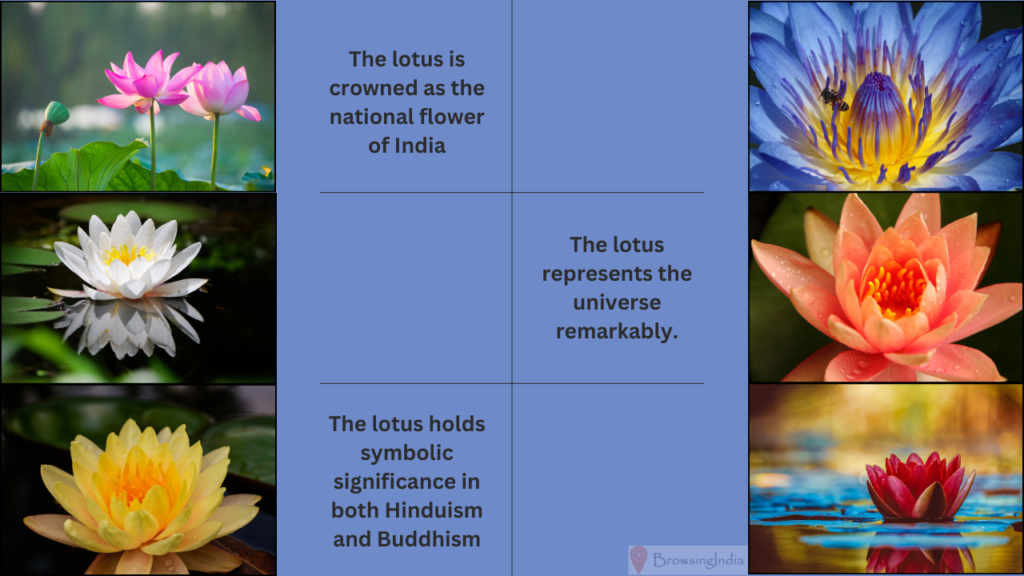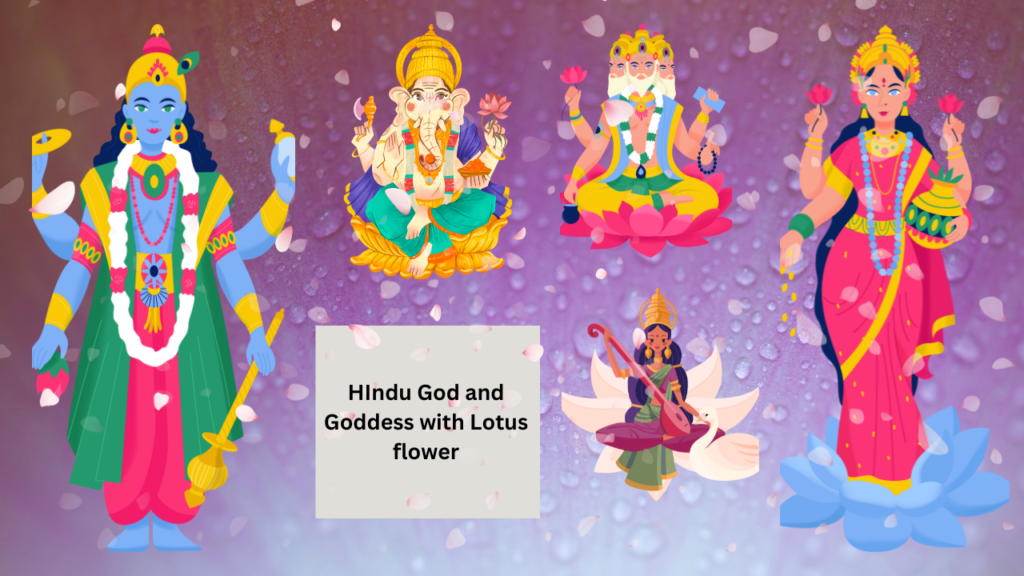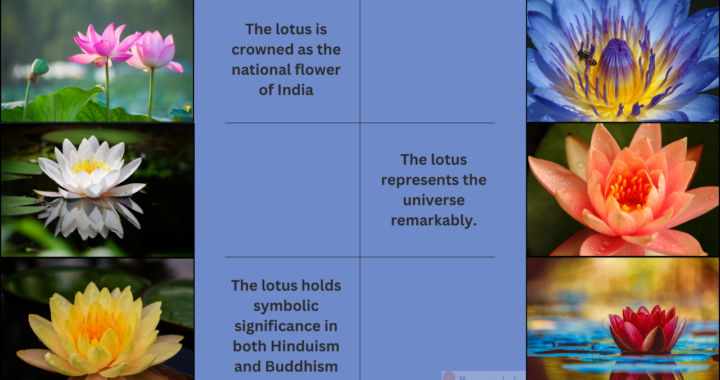
The lotus is crowned as the national flower of India. It holds a special place in the country’s art, culture, and spirituality, symbolizing its rich heritage since ancient times.
The Lotus flower is frequently mentioned in the ancient Hindu scriptures like Rigveda, where it is referred to as Padma for the pink lotus, Kamaka for the red lotus, Pundarika for the white lotus, and Utpala for the blue lotus.
The lotus has so many different names in Sanskrit
Lotus is called kamal in hindi. It’s sanskrit names are Pankaj, Padma, पंकरुह, सरसिज, सरोज, सरोरुह, सरसीरुह, जलज, जलजात, नीरज, वारिज, अंभोरुह, अंबुज, अंभोज, अब्ज, अरविंद, नलिन, उत्पल, पुंडरीक, तामरस, इंदीवर, कुवलय, वनज .
Symbolism – Interpretation of the Lotus flower
The lotus flower holds symbolic significance in both Hinduism and Buddhism, representing various concepts and beliefs.
It symbolizes,
- Water and creation
- Purity, fertility, beauty, spirituality, eternity, prosperity
- symbols of strength, resilience, and rebirth.
- The lotus flower is used to describe feminine beauty, especially female eyes.
- It is also known to symbolize purity of speech, of the body, and the mind.
- The lotus flower’s constant growth from murky surroundings to perfect beauty is often compared to the journey of consciousness from instinctive impulses to spiritual freedom.
- The Bhagavad Gita teaches us to be like the lotus flower: performing our duties without attachment, offering our actions to God, and staying pure like water on a lotus leaf. We’re urged to rise above worldly impurities, just as the lotus rises above the mud and water.
- In the postures of hatha yoga, the lotus position, padmasana, is adopted by those aiming to attain a deep level of consciousness.
- The lotus flower can also represent the levels of faith that devotees hold within themselves. In our troubled lives, like the lotus emerging from mud to bloom, we aim to overcome difficulties and find freedom.
- The bud of the lotus symbolizes potential, specifically of a spiritual nature. The lotus is one of the eight auspicious signs of Buddhism and Hinduism, The jewel in the lotus represents the divinity of the cosmos as well as the divinity of man.
- In Buddhism, the lotus is associated with purity, spiritual awakening, and faithfulness.
- For Buddhists, the lotus flower symbolizes the highest human state: pure and elevated, yet firmly rooted in the world of experience.
All symbolism associated with the lotus seems to be positive and in the vein of being a good person and finding spiritual meaning in life.
Why is lotus used in so many metaphors?

Picture the lotus: rising tall amid muddy water, it shines with uttermost beauty.
Even if it grows in the muddy water, it blooms beautifully. not letting mud affect its beauty.
Each night it submerges into murky river water and Each morning it reblooms without residue from its environment.
Due to how it has grown, the lotus flower has come to be associated with purity and beauty in the religions of Buddhism and Hinduism, respectively.
The ancient Egyptians saw that at night the lotus closed its flowers sank into the water and opened up in the light hours. They came to associate the flower with rebirth and the sun.
Why does the Lotus have the highest position in Hinduism?

The lotus represents the universe remarkably.
Imagine a calm pond, a lotus blooming on top. But beneath, most of the lotus is hidden underwater, its tangled stem representing the mysterious start of the universe. This interplay of seen and unseen makes the lotus a symbol of the secretive universe, full of mystery and anticipation.
Why do most of the Hindu gods hold a lotus flower in their hands?
There are two lotuses. The pink and the blue.
The pink lotus is a symbol of the enlightened mind which grows in mud (contamination of material nature) but rises above the water to open to the light of the Sun.
Why does the Hindu God sit on a lotus?
The devas all stand or sit on lotuses because they appear in the enlightened minds and hold lotuses as signs of purity and the aspiration to become enlightened beings.
Some goddesses hold the closed blue lotus (nilotpala) which symbolises the universal potential for spiritual unfoldment and enlightenment.
The story related to the lotus in Hinduism
There is a story behind the first creation of the lotus flower. The Lotus came from Vishnu’s navel, from the center of this flower born Brahma. Brahma, Vishnu, and Siva are connected to the lotus, symbolizing creation, protection, and dissolution. In Padmapurana there are stories about the world’s creation through a “Golden Lotus” and the Lotus Age.
“Visualize within yourself a lotus, centered right within your heart.”
Hindu scriptures say that the Atman dwells in the lotus within the heart. Visualize
a lotus flower right within you.
Behind the Significance of Lotus in Hinduism
People often compare life’s journey to that of a lotus. It starts as a seed, moves through the bud stage emerging from muddy waters, representing spiritual growth and detachment from worldly things. Ultimately, the lotus fully blooms, symbolizing awakening and reaching nirvana.
Hindu God and Goddess with lotus flower

In Hinduism, several gods and goddesses are associated with sitting on a lotus flower.
- Lord Vishnu: He is often depicted resting on the thousand-headed serpent Adi Shesha. The lotus is emerging from his navel upon which the god Brahma is seated.
- Goddess Lakshmi: She is seated on a fully bloomed lotus, symbolizing purity, prosperity, and divine grace. She is also holding lotus in her right hand. As per the Mahabharata, she was also born from a lotus flower which grew from the forehead of the Lord Vishnu.
- Lord Brahma: He is believed to be born from the lotus flower that rises from Lord Vishnu’s navel which symbolizes creation and the unfolding of the universe.
- Saraswati – The Goddess of wisdom is also associated with white lotus. She is also sitting on the fully bloomed white lotus flower.
- Ganesha – Lord Ganesha also sits on the lotus flower. The lotus flower in his hand signifies enlightenment.
In Hinduism, almost all the deities are associated with the lotus flower. They sit on the lotus, also they hold it in their hands. Their lotus dseat is called padmasana or kamalasana.
Lotus from the Hindu scriptures
In Bhagavad Gita (Ch 5. 10)
“Brahmany adhaya karmani sangam tyaktva karoti yah
Lipyate na sa papena padma patra ivambhasa”
Meaning: One who does all work as an offering to the Lord without attachment to the results is untouched by Karma, just as a lotus leaf is untouched by water”.
The Vedas speak of the very core of human existence, where the soul resides in the form of a lotus flower. The heart, the house of God, is likened to Hridaya Kamalam, the lotus of the heart.
The lotus is a powerful symbol in the Hindu tantric tradition. Representing the seven energy centers in the body, known as chakras, each chakra is represented by a different lotus with varying numbers of petals. Starting from the root chakra at the base of the spine with four petals, to the crown chakra located at the top of one’s head which has a thousand petals, these symbolic flowers serve as reminders that we can reach our highest potential.
Different colors of the Lotus and importance

The color of the lotus flower is significant in Hinduism, with each hue representing a different deity or attribute.
The white lotus is associated with Brahma, the creator god, and symbolizes purity and spiritual awakening.
The yellow lotus is associated with Saraswati, the goddess of knowledge, and stands for learning education, and creative intelligence.
The red lotus is linked to Lakshmi, the goddess of wealth and prosperity, which represents success and abundance.
Finally, the pink lotus flower is considered the most divine and only awarded to those of the highest standing; it also symbolizes love in many parts of India.
Lotus in Greek mythology
In Greek mythology, the lotus flower held significance for numerous deities, including Hera, Athena, and Aphrodite. It frequently appeared in Greek art, symbolizing attributes like beauty, elegance, and divine authority. A well-known narrative featuring the lotus flower is the tale of Odysseus and the Lotus Eaters.
Conclusion
Simply put, the lotus flower symbolizes beauty, purity, fertility, prosperity, and enlightenment in Hindu and Buddhist architecture across the globe. In Hinduism almost every God is either holding the lotus flower or sitting on the lotus flower. The lotus flower is great metaphor for unmanifested universe. Considering how it grows, it inspires the people to pursue their spiritual journey.

